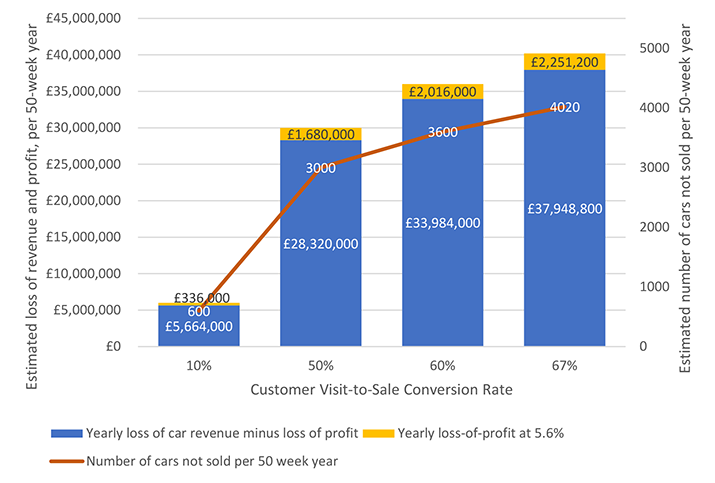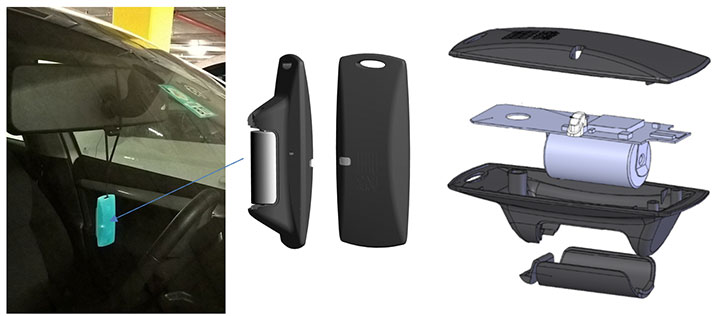How the IoT Can Improve Customer Experience Profits and More in Automotive Retail
Businesses see massive opportunities in the IoT (Internet of Things) but are also aware of significant challenges. Quantifying the Return of Investment (ROI) and finding a clear use case has been identified [1] as the most immediate challenge for IoT professionals. In this article, we show how the IoT can be used in a concrete and viable business scenario to improve customer experience in an example based on an automotive retailer.
The automotive industry faces many challenges to increase turnover, revenues and profitability. For retailers (i.e. the car dealerships), these challenges will be met by increasing the number of cars and the related services that they sell (routine maintenance, repair services). However, sales are influenced by the customer experience (CX) and while a good one may help dealerships sell more cars, a bad experience will certainly not. This is important as, until recently, typically customers visited a dealership four times before making a purchase. Now, over half of the cars are sold on the first visit [2][3] and 67% within two visits [4]; the CX on the first visit clearly matters.
A frequent CX problem for dealerships with over 400 cars per site is locating the ones that the customers want to see or test-drive. For various reasons, cars are often parked in ‘the wrong place’ (for example, after previous test-drives). The longer before they are found, the worse the customer experience becomes. This results in ‘lost sales’ and the more sales affected per site, the greater the financial loss.

Figure 1: Estimated Loss of Revenue and Profit, Per 50-Week Year, at Different Sale Conversion Rates.
Figure 1 quantifies the loss of revenue and profit, per 50-week year, for a used car supermarket. The site has 30 salespeople. On average, every salesperson will be unable to find a car, without a lengthy delay, four times a week, potentially resulting in a ‘lost sale’. This is 120 potential ‘lost sale’ events per week (30 x 4 = 120), or 6,000 per 50-week year (120 x 50). The average sale price is £10,000, incorporating a 5.6% profit margin. However, not all events are true ‘lost sales’, because not all customer visits result in a car being sold. A more accurate estimate of the number of ‘lost sales’ comes from the customer visit-to-sale conversion rates cited by dealers themselves. These are that over half of the cars are bought on the first visit [2][3] (indicated by the values of 50% and 60%, with the ‘true’ figure expected to lie somewhere in this range), and 67% within two visits [4]. The figure of 10% gives a more conservative estimated loss, reflecting that even if many ‘lost sales’ are recovered throughout the year, losses are still significant.
Lengthy delays also result in lower customer review ratings, lower net promoter scores (NPS) and damage dealers’ reputations. In turn, when reputational damage causes dealerships to sell fewer cars, manufacturers make lower returns as a result.
Konica Minolta Laboratory Europe is developing an IoT-based solution, named The Shepherd, to help overcome these challenges. It accurately enough locates vehicles, both indoors and outdoors, to within range of an electronic car key/fob. Just as shepherds need to know where all of their flock are, car retailers need to know where all of their vehicles are. This allows them to be found, test-driven and then sold, quickly.
The Shepherd locates the vehicles without extensive power or infrastructure requirements, meaning no expensive set-up, service, maintenance or running costs.
- Each vehicle is fitted with a small, battery-powered device (see Figure 2), which hangs from the rear-view mirror and uses radio signals to measure its distance to similar devices in the surrounding vehicles.
- The relative distance measurements from the digital ‘flock’ are wirelessly transmitted via LoRaWAN to a central server that calculates an absolute position of each vehicle.

Figure 2: Tracking device (approx. 2cm x 3cm x 4cm).
One LoRa Gateway can cover a parking area of 2 km radius. Provided each of the tracked vehicles is within 20 m of at least three neighbouring vehicles, the tracking devices form a mesh network, in which any car in the flock can be located to within 10 – 15 m. The use of a sensor network localization provides the lowest deployment and operating costs while preserving sufficient accuracy:
- Unlike Bluetooth / Bluetooth Low Energy (BLE) it does not require any beacons distributed across the site.
- Unlike GPS it works under the cover of a roof and in multi-floor parking houses, and even if the cars are covered by snow.
- Unlike Ultra Wideband (UWB) or Wi-Fi the tag can run on a small battery for as long as 3 years.
When a vehicle arrives, The Shepherd discovers its position in a flock within five minutes. This provides near real-time location updates that can be shown on a user’s IT system, or tablet or smart phone, via an app. The tracking devices are conveniently reused after a vehicle is sold.
By locating any car within the parking area, the dealers can:
- Improve their CX, customer review ratings, NPS and brand reputation.
- Reduce the number of ‘lost sales’ caused by lengthy delays, increase inventory turnover and boost sales of higher-margin services, including finance, warranties, insurance, service and maintenance, and valeting.
- Reclaim employee time and increase the return on capital employed.
After integrating the location information into the dealership’s or another information management system and augmenting the existing inventory information The Shepherd will also:
- Accurately display the movement of cars within or between geographical areas.
- Automatically register deliveries and transfers on arrival, to save time spent on manual recording and data entry.
- Provide data analytics on test-drive frequencies, to record consumer trends or optimise stock management.
The Shepherd is currently under development and can only be offered on a trial basis at this time, as either a hosted or managed service. We are interested in getting feedback from potential users to confirm the value and usefulness of our development.
References
[1] Canonical, (2017). Defining IoT Business Models, at https://pages.ubuntu.com/IOT_IoTReport2017.html.
[2] McKinsey & Company, (2014). Innovating automotive retail. Downloaded from the World Wide Web on April 24th, 2018 at: https://www.mckinsey.com/industries/automotive-and-assembly/our-insights/innovating-automotive-retail.
[3] Marshall Motors, (2018). Personal communication.
[4] Inchcape PLC, (2018). Annual Report and Accounts 2017, p. 6. Downloaded from the World Wide Web on April 12th, 2018 at: http://www.annualreports.com/HostedData/AnnualReports/PDF/LSE_INCH_2017.pdf.
 John Shah led commercialisation of The Shepherd as an Incubation Manager at Konica Minolta's Business Innovation Centre, Europe. He has 10 years experience in leadership roles, developing new products and services for the automotive, energy, utility, medical imaging and biopharmaceutical sectors. He received his B.Sc. in Molecular Biology from the University of London and carried out research in experimental medicine at Oxford University's Department of Pharmacology. He can be contacted at johnshah3000@gmail.com.
John Shah led commercialisation of The Shepherd as an Incubation Manager at Konica Minolta's Business Innovation Centre, Europe. He has 10 years experience in leadership roles, developing new products and services for the automotive, energy, utility, medical imaging and biopharmaceutical sectors. He received his B.Sc. in Molecular Biology from the University of London and carried out research in experimental medicine at Oxford University's Department of Pharmacology. He can be contacted at johnshah3000@gmail.com.
 Petr Gotthard is a research specialist for the internet of things in Konica Minolta Laboratory Europe. He is focused on design and development of affordable LoRaWAN solutions. Petr has fifteen years’ experience in software engineering, solutions architecture, systems integration and leadership roles in high-tech companies. He received his MS in electrical engineering and computer science from the Brno University of Technology. Contact him at petr.gotthard@konicaminolta.cz.
Petr Gotthard is a research specialist for the internet of things in Konica Minolta Laboratory Europe. He is focused on design and development of affordable LoRaWAN solutions. Petr has fifteen years’ experience in software engineering, solutions architecture, systems integration and leadership roles in high-tech companies. He received his MS in electrical engineering and computer science from the Brno University of Technology. Contact him at petr.gotthard@konicaminolta.cz.
 Tomáš Jankech is a research engineer for embedded devices in Konica Minolta Laboratory Europe. He is focused on design of low-power wireless devices. Tomáš received his MS in electronics and communication from the Brno University of Technology. Contact him at tomas.jankech@konicaminolta.cz.
Tomáš Jankech is a research engineer for embedded devices in Konica Minolta Laboratory Europe. He is focused on design of low-power wireless devices. Tomáš received his MS in electronics and communication from the Brno University of Technology. Contact him at tomas.jankech@konicaminolta.cz.
Sign Up for IoT Technical Community Updates
Calendar of Events
IEEE 8th World Forum on Internet of Things (WF-IoT) 2022
26 October-11 November 2022
Call for Papers
IEEE Internet of Things Journal
Special issue on Towards Intelligence for Space-Air-Ground Integrated Internet of Things
Submission Deadline: 1 November 2022
Special issue on Smart Blockchain for IoT Trust, Security and Privacy
Submission Deadline: 15 November 2022
Past Issues
September 2022
July 2022
March 2022
January 2022
November 2021
September 2021
July 2021
May 2021
March 2021
January 2021
November 2020
July 2020
May 2020
March 2020
January 2020
November 2019
September 2019
July 2019
May 2019
March 2019
January 2019
November 2018
September 2018
July 2018
May 2018
March 2018
January 2018
November 2017
September 2017
July 2017
May 2017
March 2017
January 2017
November 2016
September 2016
July 2016
May 2016
March 2016
January 2016
November 2015
September 2015
July 2015
May 2015
March 2015
January 2015
November 2014
September 2014


